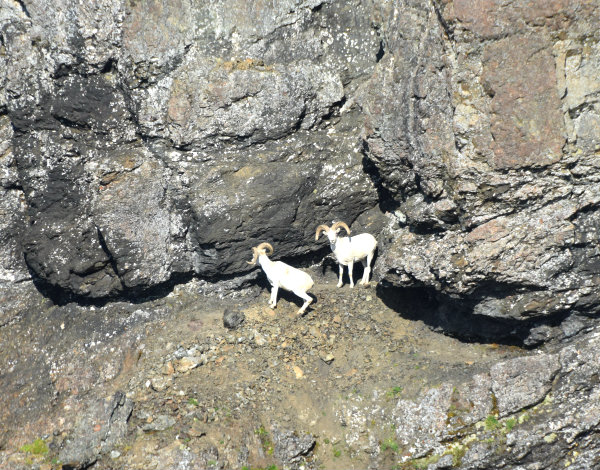Arial surveys are a great way to monitor animal populations because it lets biologist cover lots of ground quickly. It’s especially important in a park as big as Noatak National Preserve. At more than 6 million acres large, Noatak National Preserve is the 3rd largest national preserve in the United States. Without an airplane, it would be impossible for scientists, such as National Park Service wildlife biologist Hillary Robison, to perform accurate wildlife surveys. Hilary spent last week surveying Dall’s sheep populations in the Baird and Delong Mountains in Noatak National Preserve.
Weather was mostly clear with good visibility. There are still patches of snow in the Baird and Delong Mountains, and there’s even aufeis [thick sheets of ice that form along or near rivers; they can last long into summer] on Trail Creek and the Nimiuktuk and Kelly River. The rivers are flowing clear and the vegetation in the mountains and hills was very green and lush. We saw tons of wildlife. In addition to the Dall’s sheep we were looking for, we saw caribou, moose, golden eagles, brown bears, ospreys and gulls. We even saw grayling [a type of fish] surfacing in the rivers. Sheep numbers appear to still be low, but we saw some lambs, which was encouraging. We had great weather for surveying!

Two male Dall's sheep look upwards at the passing plane. NPS Photo/Hillary Robison

An ewe watches as a plane passes overhead. NPS Photo/Hillary Robison

Hard to think of an office with a better view. NPS Photo/Hillary Robison
Dall’s sheep live high in the craggy peaks of Alaska’s mountains, feeding on grass, sedges and other plants growing on the steep slopes and hiding from predators in the rocky crags. Their most distinctive features are the large, curving horns the males sport and their impressive head-butting displays during rut. Ewes (females) also have horns, but they are much smaller and less curved than the males’. While Alaska’s overall Dall’s sheep population is healthy, numbers in the Brooks Range have dropped dramatically in the past few years, and it is important for biologists to monitor them closely.
